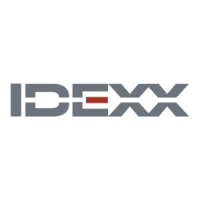)o
Chemistry Description and Guide
UPC Protocol
Principle reason for performing test:
5PBJEJOUIFEJBHOPTJTPGQSPUFJOMPTJOHOFQISPQBUIJFTTVDIBTHMPNFSVMPOFQISJUJTBOE
amyloidosis and as an early marker of chronic renal failure.
Includes:
Urine protein, urine creatinine, protein:creatinine ratio
Submission Requirements:
2 mL urine in a sterile container
Storage/Stability:
IPVSTBU×o×$
Interferences:
Gross hematuria, pyuria. Complementary tests include complete urinalysis with culture
and sensitivity. Serum chemistries such as creatinine, BUN, albumin, globulin, CBC,
4/"1%YBOEJNBHJOHTUVEJFT
Interpretation:
Proteinuria requires proof of persistence and localization to prerenal, renal or postrenal
origins. Prove persistence of proteinuria by repeating the UPC (urine protein:creatinine) ratio
at least three times, a minimum of two weeks apart.
Prerenal proteinuria is possible when a CBC and a biochemical profile detect t
hemolysis, hyperglobulinemia or evidence of muscle damage. Recommend
investigation and management for the underlying cause.
Postrenal proteinuria is caused by urogenital tract diseases, hematuria or pyuria. t
Repeat the test with a cystocentesis sample or evaluate urine sediment for
hemorrhage or inflammation. Consider a urine culture. Recommend investigation
and management for the underlying cause.
Renal proteinuria: evaluate in the face of azotemiat
Nonazotemic, persistent, renal proteinuria (dogs and cats):
61$XJUIJOSFGFSFODFJOUFSWBM
61$oRVFTUJPOBCMFSFQFBUBUBQQSPQSJBUFJOUFSWBM
UPC 1.0–2.0=excessive proteinuria; recommend investigation for underlying
systemic diseases
UPC ≥2.0=excessive proteinuria; recommend investigation for underlying
systemic diseases and medical management
Azotemic, persistent, renal proteinuria (dogs):
61$XBSSBOUNPOJUPSJOHBOEJOWFTUJHBUJPO
UPC ≥FYDFTTJWFQSPUFJOVSJBSFDPNNFOEJOWFTUJHBUJPOGPSVOEFSMZJOH
systemic diseases and medical management
Azotemic, persistent, renal proteinuria (cats):
61$XBSSBOUNPOJUPSJOHBOEJOWFTUJHBUJPO
UPC ≥FYDFTTJWFQSPUFJOVSJBSFDPNNFOEJOWFTUJHBUJPOGPSVOEFSMZJOH
systemic diseases and medical management

